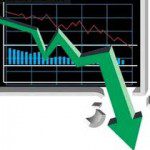How could everything be selling off at once? Aren’t the various different asset  classes (stocks, bonds, gold) meant to be hedges against each other? The simple answer is that although it would be great if that were the case, it isn’t — it never was.
classes (stocks, bonds, gold) meant to be hedges against each other? The simple answer is that although it would be great if that were the case, it isn’t — it never was.
So writes Felix Salmon (http://blogs.reuters.com) in edited excerpts from his original article* entitled Markets Revert To Common Sense.
[The following article is presented by Lorimer Wilson, editor of www.munKNEE.com and may have been edited ([ ]), abridged (…) and/or reformatted (some sub-titles and bold/italics emphases) for the sake of clarity and brevity to ensure a fast and easy read. This paragraph must be included in any article re-posting to avoid copyright infringement.]
Salmon goes on to say in further edited excerpts:
You do get a certain amount of diversification benefit by investing in a series of asset classes, but, as we all learned during the financial crisis, correlations have a tendency to go to 1 exactly when you don’t want them to…
There’s something counterintuitive here: if money leaves one asset class, you’d think that it should turn up in another. You can’t have everything fall at once but the fact is that you can. Volume was heavy Thursday — but remember that, as always, the number of shares bought was exactly the same as the number of shares sold.
_____
Save time! Here are 4 ways to access the best articles on the internet!
Sign up for our FREE Market Intelligence Report newsletter (sample)
“Follow the munKNEE” daily posts via Twitter or Facebook
Set up an RSS feed: It’s really easy – here’s how
_____
What we really saw Thursday was not a move out of stocks, or bonds, or gold, but rather a repricing within each asset class. Think of it this way: if the price of Damien Hirst paintings falls, that doesn’t mean lots of people are selling them. Quite the opposite. It just means that potential buyers aren’t willing to pay as much for such things as they used to.
Buy-and-hold investors can safely ignore everything that’s going on here, or possibly step up their buying pace if prices start looking increasingly attractive, because the big picture here is that what we’re seeing is markets returning to normal — or, to be more precise, markets anticipating that, finally, almost five years after the crisis hit, a return to normal might be coming at some point in the foreseeable future.
“Normal”, here, just means:
- a world where the Fed isn’t dropping money from helicopters;
- a world where global interest rates aren’t all stuck at zero;
- a world where real interest rates can’t happily sit in negative territory for years on end;
- a world where metals don’t have especial value just because they’re particularly shiny;
- a world, most broadly, where assets are valued based on fundamentals, rather than being based on capital flows.
At his press conference last Wednesday, Ben Bernanke reiterated his view that the way QE works is through simple supply and demand: since the Fed is buying up fixed-income assets, that means fewer such assets to go round for everybody else, and therefore higher prices on those assets and lower yields generally.
In reality, however, the flow always mattered more than the stock: when the Fed is in the market every day, buying up assets, that supports prices more than the fact that they’re sitting on a large balance sheet. Even more important is the bigger message sent by those purchases: that we’re in a world of highly heterodox monetary policy, where the world’s central banks can help send asset prices, especially in the fixed-income world, to levels they would never be able to reach unaided.
Traders always try to skate to where the puck is going: if they see that the Fed is embarking on a round of QE, they’re going to start buying up assets so long as they’re cheaper than they will be at the end of that round. Similarly, once the Fed signals that it’s on its last round of QE and that from here on in monetary policy is only going to get tighter, they’re going to sell assets so long as they’re more expensive than they will be once money is no longer falling from helicopters.
Conclusion
The common thread which explains all of the different market moves over the past couple of days is that they’re all part of what you might call the “reversion to sensible” trade:
- if real rates are bizarrely low, they will rise;
- if the Australian currency is bizarrely strong, it will fall;
- if emerging-market debt has rallied to the point at which it no longer prices in all the idiosyncratic risks associated with buying assets governed by Ruritanian law and denominated in the Ruritanian currency, then it too will fall — a lot.
In the long term, this is a good thing: it means that markets are doing their primary job, which is price discovery. In the short term, of course, there will be disruption and volatility. It’s not going to be easy getting there from here but if you’re an investor, rather than a trader, there’s nothing to worry about here. In fact, there’s a lot to welcome.
[Editor’s Note: The author’s views and conclusions in the above article are unaltered and no personal comments have been included to maintain the integrity of the original post. Furthermore, the views, conclusions and any recommendations offered in this article are not to be construed as an endorsement of such by the editor.]
*http://blogs.reuters.com/felix-salmon/2013/06/20/markets-revert-to-common-sense/
Related Articles:
1. 30 Analyses of Why Stock Markets Are Tanking – Finally
There are many, many different takes on why the stock market has been ripe for a fall and why it has finally happened. Below are 30 of the best-of-the-best such analyses to help you come to some sort of resolution. Read More »
2. S&P 500 Likely to Drop Further – Here’s Why
I believe this sell-off is a good thing for the market – as the outcome will show us where fair value might be. I believe that we will see the market return to a more reasonable forward P/E of 13, sending SPY to $150.00 – or another 5 percent decline. [Let me explain further.] Read More »
3. Gold & Gold Stocks: A Look At the Current Weakness & Future Expectations
Nearly all markets except the dollar reacted rather badly to Ben Bernanke’s news conference – even though it actually contained no news – Treasury yields soared, stocks were whacked, and so was gold. While the charts certainly don’t look good in the short term, though, it should be pointed out though that investors with a longer time horizon probably won’t make a big mistake by buying on weakness. That being said, however, in the short term all the tentative evidence that a bottoming process may be under way has by now been eradicated. Below are a number of charts illustrating the situation. Read More »
4. Almost Every Single Asset Class Is Overvalued! Hardly – Here’s Why
A recent Trim Tabs report claims that almost every single asset class in the world is overvalued yet, while there may be some areas that are frothy, to claim that almost every single asset class in the world is overvalued is a bit of a stretch. This article refutes these claims. Read More »
 munKNEE.com Your Key to Making Money
munKNEE.com Your Key to Making Money


